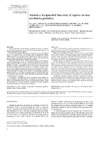Identificador persistente para citar o vincular este elemento:
https://accedacris.ulpgc.es/handle/10553/74347
| Campo DC | Valor | idioma |
|---|---|---|
| dc.contributor.author | Anía Lafuente, B. J. | en_US |
| dc.contributor.author | Fernández-Burriel Tercero, Miguel | en_US |
| dc.contributor.author | Suárez Almenara, J. L. | en_US |
| dc.contributor.author | Betancort Mastrángelo, C. C. | en_US |
| dc.contributor.author | Guerra Hernández, L. | en_US |
| dc.date.accessioned | 2020-09-10T11:40:45Z | - |
| dc.date.available | 2020-09-10T11:40:45Z | - |
| dc.date.issued | 2001 | en_US |
| dc.identifier.issn | 0212-7199 | en_US |
| dc.identifier.other | Scopus | - |
| dc.identifier.uri | https://accedacris.ulpgc.es/handle/10553/74347 | - |
| dc.description.abstract | AIM: To ascertain the prevalence of anemia on admission to a nursing home, and to assess the relationship between the observed cases of anemia and the functional status of those subjects. METHODS: We studied 198 subjects: 82 men (41%) aged 75.8 +/- 8.8 years, and 116 women (59%) aged 78.2 +/- 8.3 years. Anemia was diagnosed according to the criteria of the World Health Organization. The classification as non-disabled, or physically or mentally disabled, was done according to the Scales of the Spanish Red Cross. RESULTS: Anemia was diagnosed in 36% of the males, being microcytic in 14%, normocytic in 83%, and macrocytic only in 3% of them. Among women there were 44% with anemia, which was microcytic in 16%, normocytic in 80%, and macrocytic in 4% of cases. The prevalence of anemia increased with age in both sexes. Among men, anemia was significantly associated (p = 0.013) with physical disability, whereas among women this association just fell off significance (p = 0.06). There was no association of anemia with mental disability. No association was found between serum concentrations of ferritin, vitamin B12, or folic acid, and the classification as non-disabled, or as physically or mentally disabled. CONCLUSIONS: Anemia is found in about 40% of the elderly on admission to our nursing home. Anemia is associated with older age and with physical disability, but not with mental disability. Whether anemia on admission entails a higher risk of disability onset during the stay in the nursing home remains to be elucidated. | en_US |
| dc.description.abstract | Objetivo: Establecer la prevalencia de anemia en ancianos al ingreso en una residencia, así como la relación de las anemias detectadas con el estado funcional de dichos sujetos. Método: Se estudiaron 198 sujetos: 82 varones (41 %) con 75,8±8,8años y 116 mujeres (59%) con 78,2±8,3 años. Se diagnosticó anemia según los criterios de la Organización Mundial de la Salud, y la clasificación en válidos o asistidos físicos o mentales se llevó a cabo mediante las Escalas de Incapacidad Física y Mental de Cruz Roja. Resultados: El 36% de los varones tenía anemia, que era microcítica en el 14%, normocítica en el 83% y macrocítica sólo en el 3%. Entre las mujeres había un 44% con anemia, que era microcítica en el 16%, nor-mocítica en el 80% y macrocítica en el 4% de los casos. La prevalenciade anemia aumentó con la edad en ambos sexos. Entre los varones la anemia se asoció significativamente (P=0,013) a la incapacidad física, mientras que en las mujeres dicha asociación estuvo en el límite de la significación (P=0,06). La anemia no se asoció a la incapacidad mental en ninguno de los sexos. No hubo asociación entre las concentraciones séricas de ferritina, vitamina B12 o ácido fólico y la clasificación en válidos y asistidos físicos o mentales. Conclusiones: Alrededor del 40% de los ancianos que ingresan en nuestra residencia presentan anemia. La anemia se asocia a la mayor edad y a la incapacidad física, pero no a la incapacidad mental. Queda por determinar si la anemia al ingreso condiciona un mayor riesgo de incapacitación durante la estancia en la residencia. | en_US |
| dc.language | spa | en_US |
| dc.relation.ispartof | Anales de Medicina Interna | en_US |
| dc.source | Anales de Medicina Interna [ISSN 0212-7199], v. 18 (1), p. 9-12, (Enero 2001) | en_US |
| dc.subject | 320107 Geriatría | en_US |
| dc.subject.other | Anemia | en_US |
| dc.subject.other | Incapacidad | en_US |
| dc.subject.other | Residencia geriátrica | en_US |
| dc.subject.other | Anciano válido | en_US |
| dc.subject.other | Anciano asistido | en_US |
| dc.subject.other | Disability | en_US |
| dc.subject.other | Nursing home | en_US |
| dc.subject.other | Non-disabled elderly | en_US |
| dc.subject.other | Disabled elderly | en_US |
| dc.title | Anemia e incapacidad funcional al ingreso en una residencia geriátrica | en_US |
| dc.title.alternative | Anemia and functional incapacity at admission to a geriatric home | en_US |
| dc.type | info:eu-repo/semantics/Article | en_US |
| dc.type | Article | en_US |
| dc.identifier.scopus | 0035222205 | - |
| dc.contributor.authorscopusid | 6601916532 | - |
| dc.contributor.authorscopusid | 6507688751 | - |
| dc.contributor.authorscopusid | 6506415234 | - |
| dc.contributor.authorscopusid | 6507353421 | - |
| dc.contributor.authorscopusid | 6507978241 | - |
| dc.description.lastpage | 12 | en_US |
| dc.identifier.issue | 1 | - |
| dc.description.firstpage | 9 | en_US |
| dc.relation.volume | 18 | en_US |
| dc.investigacion | Ciencias de la Salud | en_US |
| dc.type2 | Artículo | en_US |
| dc.utils.revision | Sí | en_US |
| dc.date.coverdate | Enero 2001 | en_US |
| dc.identifier.ulpgc | Sí | es |
| item.fulltext | Con texto completo | - |
| item.grantfulltext | open | - |
| Colección: | Artículos | |
Citas SCOPUSTM
4
actualizado el 08-jun-2025
Visitas
67
actualizado el 11-may-2024
Descargas
71
actualizado el 11-may-2024
Google ScholarTM
Verifica
Comparte
Exporta metadatos
Los elementos en ULPGC accedaCRIS están protegidos por derechos de autor con todos los derechos reservados, a menos que se indique lo contrario.
